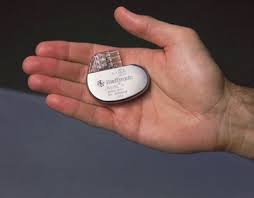

The purpose of a pacemaker is to prevent the heart from beating too slowly. It is therefore indicated for people who have symptoms related to a slow heart rhythm.
The pacemaker itself is a device which contains a battery and can be programmed remotely from over the skin. It is positioned using a small incision under local anaesthetic which is usually in the left upper chest wall below the collar bone and is around 3-4cm long. The pacemaker is connected to one or more electrical wires (“leads”) which are passed down a vein and positioned in the heart using X-ray.
The procedure is carried out with local anaesthetic and often with a small dose of sedation into the vein. It normally takes 45-60 minutes to do this for a pacemaker with one or two leads.
The risk of pacemaker implantation is around 5% in total and includes the following:
1) lead displacement, which may require a further procedure to reposition the lead.
2) it is quite common to get some bruising but rarely a collection of blood (called a haematoma) may develop, and this may require a repeat procedure.
3) infection occurs in around 1% of pacemakers despite using antibiotics and carrying out the procedure in a sterile fashion.
4) rarely an air leak around the lung or blood leak around the heart may occur and require a drain to be inserted.